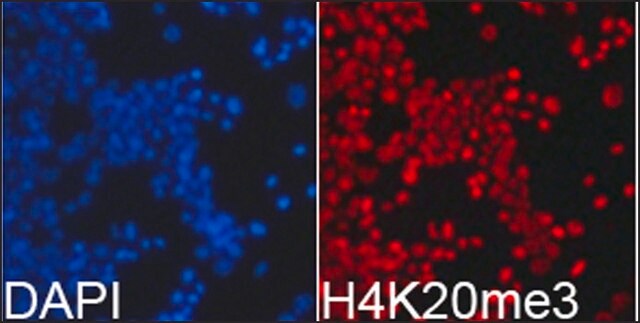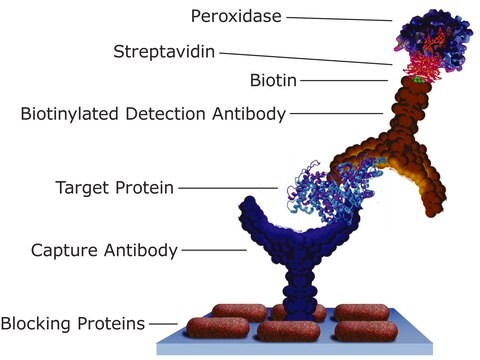17-10047
ChIPAb+ Histone H4 - ChIP Validated Antibody and Primer Set, rabbit monoclonal
from rabbit
Synonym(s):
H4, Histone H4, H4 histone family, member A, histone 1, H4a, histone cluster 1, H4a
Sign Into View Organizational & Contract Pricing
All Photos(3)
About This Item
UNSPSC Code:
12352203
eCl@ss:
32160702
NACRES:
NA.32
Recommended Products
biological source
rabbit
Quality Level
clone
monoclonal
species reactivity
human
manufacturer/tradename
ChIPAb+
Upstate®
technique(s)
ChIP: suitable
immunoprecipitation (IP): suitable
western blot: suitable
NCBI accession no.
UniProt accession no.
shipped in
dry ice
General description
All ChIPAb+ antibodies are individually validated for chromatin precipitation, every lot, every time. Each ChIPAb+ antibody set includes control primers (tested every lot by qPCR) to biologically validate your IP results in a locus-specific context. The qPCR protocol and primer sequences are provided, allowing researchers to validate ChIP protocols when using our antibody in their chromatin context. Each set also includes a negative control antibody to ensure specificity of the ChIP reaction.
The ChIPAb+ Histone H4 set includes the Histone H4 antibody, a negative control antibody (normal rabbit IgG), and qPCR primers which amplify a 110 bp region of human β-Globin. The Histone H4 and negative control antibodies are supplied in a scalable "per ChIP" reaction size and can be used to functionally validate the precipitation of Histone H4-associated chromatin.
The ChIPAb+ Histone H4 set includes the Histone H4 antibody, a negative control antibody (normal rabbit IgG), and qPCR primers which amplify a 110 bp region of human β-Globin. The Histone H4 and negative control antibodies are supplied in a scalable "per ChIP" reaction size and can be used to functionally validate the precipitation of Histone H4-associated chromatin.
Specificity
Wide range of cross-reactivity expected based on sequence homology.
Immunogen
Epitope: a.a 25-28
KLH-conjugated synthetic peptide corres-ponding to amino acids 17-28 of Histone H4.
Application
Chromatin Immunoprecipitation:
Sonicated chromatin prepared from HeLa cells (1 X 106 cell equivalents per IP) were subjected to chromatin immunoprecipitation using 2 µL of either normal rabbit IgG or 2 µL of Anti-Histone H4 antibody and the Magna ChIP A Kit (Cat. # 17-610).
Successful immunoprecipitation of total Histone H4 associated DNA fragments was verified by qPCR using ChIP Primers, β-Globin, as well as GAPDH promoter Control Primers, (Please see figures).
Data is presented as percent input of each IP sample relative to input chromatin for each amplicon and ChIP sample as indicated.
Please refer to the EZ-Magna ChIP A (Cat. # 17-408) or EZ-ChIP (Cat. # 17-371) protocol for experimental details.
Western Blot Analysis:
Representative Lot Data.
HeLa Acid Extract (Lane 1 and 3), HeLa Acid Extract from sodium butyrate treated cells (Lane 2), HeLa Acid Extract from colcemid treated cells (Lane 4) and recombinant histone H4 (Lane 5) were resolved by electrophoresis, transferred to PVDF membranes and probed with Anti-Histone H4 (1:1,000 dilution).
Proteins were visualized using a Donkey anti-rabbit IgG conjugated to HRP and visualized using a chemiluminescence detection system. (Please see figures).
Sonicated chromatin prepared from HeLa cells (1 X 106 cell equivalents per IP) were subjected to chromatin immunoprecipitation using 2 µL of either normal rabbit IgG or 2 µL of Anti-Histone H4 antibody and the Magna ChIP A Kit (Cat. # 17-610).
Successful immunoprecipitation of total Histone H4 associated DNA fragments was verified by qPCR using ChIP Primers, β-Globin, as well as GAPDH promoter Control Primers, (Please see figures).
Data is presented as percent input of each IP sample relative to input chromatin for each amplicon and ChIP sample as indicated.
Please refer to the EZ-Magna ChIP A (Cat. # 17-408) or EZ-ChIP (Cat. # 17-371) protocol for experimental details.
Western Blot Analysis:
Representative Lot Data.
HeLa Acid Extract (Lane 1 and 3), HeLa Acid Extract from sodium butyrate treated cells (Lane 2), HeLa Acid Extract from colcemid treated cells (Lane 4) and recombinant histone H4 (Lane 5) were resolved by electrophoresis, transferred to PVDF membranes and probed with Anti-Histone H4 (1:1,000 dilution).
Proteins were visualized using a Donkey anti-rabbit IgG conjugated to HRP and visualized using a chemiluminescence detection system. (Please see figures).
This ChIPAb+ Histone H4 -ChIP Validated Antibody & Primer Set conveniently includes the antibody & the specific control PCR primers.
Quality
Chromatin Immunoprecipitation:
Sonicated chromatin prepared from HeLa cells (1 X 106 cell equivalents per IP) were subjected to chromatin immunoprecipitation using 2 µL of either normal rabbit IgG or 2 µL of Anti-Histone H4 antibody and the Magna ChIP® A Kit (Cat. #17-610). Successful immunoprecipitation of total Histone H4 associated DNA fragments was verified by qPCR using ChIP Primers, β-Globin (Please see figures).
Please refer to the EZ-Magna ChIP A (Cat. # 17-408) or EZ-ChIP (Cat. # 17-371) protocol for experimental details.
Sonicated chromatin prepared from HeLa cells (1 X 106 cell equivalents per IP) were subjected to chromatin immunoprecipitation using 2 µL of either normal rabbit IgG or 2 µL of Anti-Histone H4 antibody and the Magna ChIP® A Kit (Cat. #17-610). Successful immunoprecipitation of total Histone H4 associated DNA fragments was verified by qPCR using ChIP Primers, β-Globin (Please see figures).
Please refer to the EZ-Magna ChIP A (Cat. # 17-408) or EZ-ChIP (Cat. # 17-371) protocol for experimental details.
Target description
~11 kDa
Physical form
Anti-Histone H4 (rabbit monoclonal IgG). One vial containing 50 µL of protein A purified rabbit monoclonal IgG supernatant in buffer containing 0.1 M Tris-Glycine (pH 7.4), 150 mM NaCl with 0.05% sodium azide before addition of glycerol to 40%. Store at -20°C.
Normal Rabbit IgG. One vial containing 75 µg of normal rabbit IgG in 75 µL storage buffer. Store at -20°C.
ChIP Primers, β-Globin. One vial containing 75 μL of 5 μM of each primer specific for human β-Globin. Store at -20°C.
FOR: AGG ACA GGT ACG GCT GTC ATC
REV: TTT ATG CCC AGC CCT GGC TC
Normal Rabbit IgG. One vial containing 75 µg of normal rabbit IgG in 75 µL storage buffer. Store at -20°C.
ChIP Primers, β-Globin. One vial containing 75 μL of 5 μM of each primer specific for human β-Globin. Store at -20°C.
FOR: AGG ACA GGT ACG GCT GTC ATC
REV: TTT ATG CCC AGC CCT GGC TC
Format: Purified
Analysis Note
Control
Includes negative control antibody (normal rabbit IgG) and primers specific for human β-Globin.
Includes negative control antibody (normal rabbit IgG) and primers specific for human β-Globin.
Legal Information
MAGNA CHIP is a registered trademark of Merck KGaA, Darmstadt, Germany
UPSTATE is a registered trademark of Merck KGaA, Darmstadt, Germany
Storage Class Code
10 - Combustible liquids
Certificates of Analysis (COA)
Search for Certificates of Analysis (COA) by entering the products Lot/Batch Number. Lot and Batch Numbers can be found on a product’s label following the words ‘Lot’ or ‘Batch’.
Already Own This Product?
Find documentation for the products that you have recently purchased in the Document Library.
CBP mediates NF-?B-dependent histone acetylation and estrogen receptor recruitment to an estrogen response element in the BIRC3 promoter.
Pradhan, M; Baumgarten, SC; Bembinster, LA; Frasor, J
Molecular and cellular biology null
Lipeng Wu et al.
Molecular cell, 49(6), 1108-1120 (2013-03-05)
Crosstalk between H2B ubiquitylation (H2Bub) and H3 K4 methylation plays important roles in coordinating functions of diverse cofactors during transcription activation. The underlying mechanism for this trans-tail signaling pathway is poorly defined in higher eukaryotes. Here, we show the following:
Xavier Brenachot et al.
Molecular metabolism, 3(6), 619-629 (2014-08-28)
Overfeeding causes rapid synaptic remodeling in hypothalamus feeding circuits. Polysialylation of cell surface molecules is a key step in this neuronal rewiring and allows normalization of food intake. Here we examined the role of hypothalamic polysialylation in the long-term maintenance
David Michod et al.
Neuron, 74(1), 122-135 (2012-04-17)
Activity-dependent modifications of chromatin are believed to contribute to dramatic changes in neuronal circuitry. The mechanisms underlying these modifications are not fully understood. The histone variant H3.3 is incorporated in a replication-independent manner into different regions of the genome, including
Our team of scientists has experience in all areas of research including Life Science, Material Science, Chemical Synthesis, Chromatography, Analytical and many others.
Contact Technical Service





